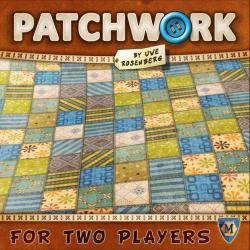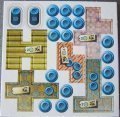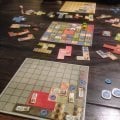 Patchwork (Board Games)
Patchwork (Board Games)
User Review
Product Information:
- Release Date (NA): January 12, 2015
- Release Date (EU): January 12, 2015
- Release Date (JP): January 12, 2015
- Publisher: Mayfair
- Developer: Uwe Rosenberg
- Genres: Abstract strategy/economic
- Also For: Android, Computer
Review Approach:
Second review, of a board game this time (though it has a great port on android and iOS. It's on steam as well). It's not a new game, but it is a good one. :)
Have you ever played a racing game where you said said to yourself "man...this game would've been so much better if it had tetris pieces"? Have you ever wanted to challenge your rival to a battle to the death quilting the most cloth together in an economical context?
What's that? You haven't until now? Well then...you're in luck. I have *just* the game for you: patchwork. :D
...
Okay...I really wanted to start this review with the trailer where a Scottish man takes on a Communist Russian bear in a thunderstorm where man's kilt got scratched and it's your job to patch it back up. But alas...it's probably taken down because of the roaring AC/DC music. In any case: this is a 1 vs 1 abstract game where you and your opponent take turns moving over a race track, getting buttons (coins) and buying available tetris-shaped pieces to place them on your field. Once you've both raced to the center of the board, the person with the most buttons and the most covered area wins the game.
THE GAME IN MORE DETAIL
Patchwork is one of the highest ranked casual board games on renowned site boardgamegeek.com. For reference: the same community rates it about 15000 spots above monopoly, so...you might want to think about this game instead if you want to buy your little nephew a birthday present.
The box contains a racetrack (two-sided, but both sides play out identical), a 9x9 board for both players, a bunch of buttons that act as currency, a few single-square pieces you put on specific parts of the racetrack, a button for each player, a single pawn...and a whole bunch of tetrominos (which is the common name for "tetris-like shapes"). Some of these shapes contain buttons; they all contain two numbers that'll make up the cost (I'll get to this in a bit).
When you and your opponent start out you put your little figure on the racetrack, you lay the tetrominos out in a large circle around the board (in any order), and put the pawn clockwise directly after the 2x1 piece. You both get 6 buttons to start, and decide a random start player. He or she will go first. After that first turn, it will always be the person's turn who is furthest away from the center. I'll repeat this because it's important: it's always the person's turn who is furthest away from the center.
In your turn, you'll always do one of two actions:
1) buy a tetronimo. On the clockwise side of the pawn, you can pick any one of three tetrominos you want and can afford. You then put the pawn forward on that location and pay the piece's cost. This cost is usually twofold.
-buttons: this is pretty straightforward: a piece that cost 5 buttons requires you to pay 5 buttons to the bank. You can't pick this piece if you don't have as much.
-time: you're on a racetrack, remember? Paying the time price of five means that as part of the cost, you've got to move your character forward five positions on the racetrack. You can always pay this, even at the end of the track.
After paying the cost, you may place your bought piece wherever you want on your board. That is: you can rotate and flip it, but it has to fit on the board entirely and not partially over another piece. Meaning: as your board fills up, it may be that you simply can't buy a piece because there's no way to properly fit in on your board.
2) pass the turn. If you pass, you move forward just enough spaces to pass your opponent. In addition, you'll get a coin for each position you pass (so if you're 2 places behind him/her, you'll get 3 buttons because you'll end up 1 in front of him/her)
Perhaps the turn order and actions per turn sound complex when explained here, but you'll quickly get the hang of it, at least for the first couple turns.
That's when the two obstacles on the racetrack come into play:
1) buttons. This is the monopoly's "go" spot: once you pass these, you'll get extra buttons. And it's here where those coin images on the tetrominos come into play: the bank pays you the same amount of buttons as you have on your board (on all tetrominos combined). Since there are quite some button marks between the outskirts and the center of the board, getting tetrominos with buttons early eventually pays them back. But of course: these are generally more expensive.
-1x1 tiles. This is where the real race comes in: the first (and only the first) player to pass this tile gets an extra 1x1 tile to put anywhere on the board. A very nice thing to have, as matching those blocks is harder than in your average tetris game.
The 1x1 tiles are also extremely important for a bonus feature of the game: the first one (and again: only the first person) to get a fully covered 7x7 grid somewhere on his/her 9x9 grid gets an extra bonus of 7 buttons. And at this point you're going to have to take my word for it: seven points often mean the difference between winning and losing. Not always, but often.
So...let's say that both sides have grabbed, puzzled and matched a nearly full board and a stack of buttons, and arrive in the center. After a last adding of buttons, the player has to wait for the other to arrive in a similar way. Once done, the score is tallied. This is done in a reasonably simple way: your end score is the number of buttons you have, minus two points for every uncovered spot on your playing board. The person with the highest score wins (note: it's perfectly possible for one or even the two players to have a negative score).
THE INTRICACIES
To me, patchwork is the prime example of a game that's both incredibly simple and incredibly complex. It's very simple in what you can do - pick one tile among three or pass - but the amount of possibilities quickly rank into zillions. There is no hidden information, but that doesn't mean it's predictable. If I pick a piece, I can directly see in advance what choices my opponent will have. Or what my second turn will be, if my opponent sprinted ahead of me. But because I don't know what piece my opponent will take (assume (s)he doesn't pass), I can only estimate what choice I will have after that turn. Assuming I haven't set myself up so that person can make two turns in a row. The end result is that you can't really rely on a certain piece for your board to come your way, even though you need that information to know how to best place the piece you buy NOW.
The game is filled with that sort of thinking. You want as much buttons on your quilt as possible, but because they'll cost more or have more inconvenient shapes, you'll be limiting yourself in the short gain to gain more buttons in the long run. You want those 1x1 pieces, but how and when do you position yourself so that YOU go over that tile first and not your opponent?
And of course: which tile will you pick? Buttons are good at the start but generally more expensive. Large tiles cover more ground but smaller ones fit niches better. Less buttons is better, and less 'time' as well (except when you want to grab a 1x1 tile), but - you guessed it - those treats never match the first set of things you want from a tetromino.
The interaction with your opponent is also rather complex. There is no direct way to screw things on the other player's field, but in the late game it's easier to predict what pieces will be in the other's interest, so you might make your turn's movement mostly to hinder him/her. I do, however, have to admit that my girlfriend and me are probably bad at this game. We might be roughly evenly matched, but when I play this game against a computer, a "normal" opponent just beats me every freaking time.
THE THEME
I'm not really sure whether I should still mention this at this point, but this really isn't a game you want to pick up for its theme. The components are simple painted carbon, the idea more abstract than meaning anything. There's this idea of patching something, but it means practically nothing. The good side to this is that this is family friendly and doesn't offend anyone (may be convenient when visiting that pious side of the family). Is that worth something to you? I guess it depends (there are some awesome video games with minimal or crude graphics as well). I also guess that if the theme bores you to death, you would have stopped reading at this point.
THE APP
The board game was released early 2015. Slightly under 2 years later, the game was released digitally on steam, iOS and android for a fraction of the price (3 bucks vs about 15). These digital versions are ports of each other, meaning that steam users will probably feel underwhelmed. But it's an incredible port of the actual game that not only adds the aforementioned Artificial Intelligence but also a striking quilt theme, online rankings and easy scorekeeping. At first the game screen may seem a bit cluttered. But you'll soon see that just about everything you need is directly where you want it: you can glance both your and your opponent's board, see each other's money, their amount of buttons on the board the incoming pieces and all their costs. The most interesting part is that it calculates both player's would-be end score should this have been the last turn (meaning: it shows the sum of your buttons minus twice the amount of empty spaces). This gives a good sense of progress during the game.
In other fields: the UI is simple and responsive. Rotating and turning a piece is intuitive, everything is on the correct display and it even has a global matchmaking system. All in all, absolutely worthy of checking out. I'd even say "even better than the board game", but that's not always the case. The board game also has a certain charm to it. A board game is something you can bring to the table (okay...not as much here since this'll only play 2 people). It's something you can do. We don't just walk up to people asking them to play a game on our phones or tablet screen.
CONCLUSION
To me, patchwork is one of my favorite one vs one games. It's economic in that you've got to weigh options, but isn't the sort of game where a stupid decision in the early game haunts you for the rest of the game. There's spacial thinking, planning ahead and hindering your opponent. And all without it coming off as being overly complex; it's just that the mechanics play so well into each other. Replayability is high (it feels like the more I play, the more I want to play), and because the game takes about half an hour to go through, it works as a nice filler or introduction game.
Verdict
What I Liked ...
- Simple to teach
- Lots of depth
- Original and smart
- No hidden information (mainly a plus for the app)
What I Didn't Like ...
- Theme is a bit bland
8
Gameplay
This is where the game shines. The choices you have to make are hard but fun and challenging. And though not exactly different, the situation will always be different enough not to get boring.
6
Presentation
Okay, the board doesn't look as shiny or attractive as the average game does. It's functional. If you like to judge books by their cover, then this may not be your board game of choice.
8
Lasting Appeal
This is one you can just keep playing, or play short bursts and then again month (probably years) later.
8.7
out of 10







